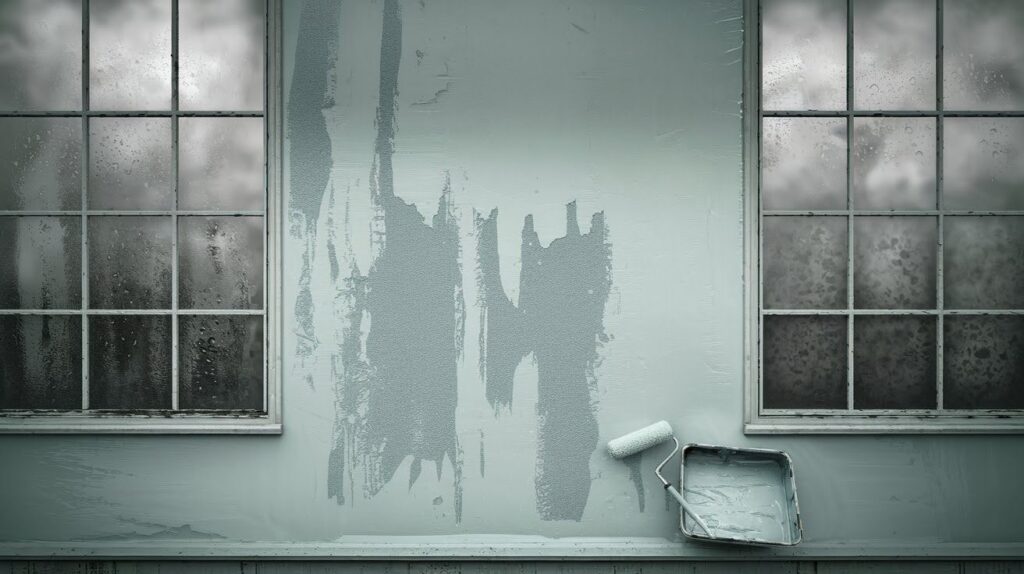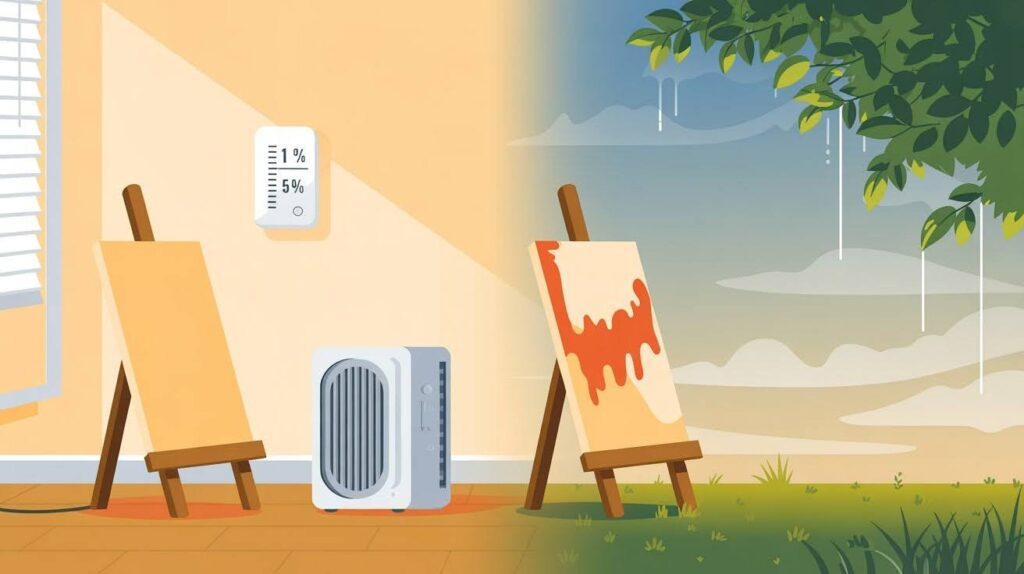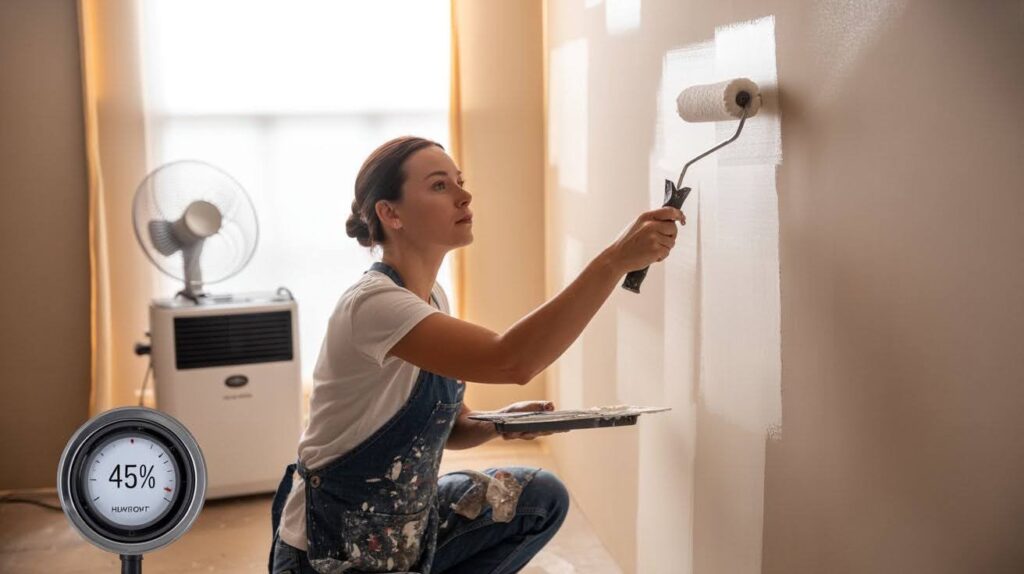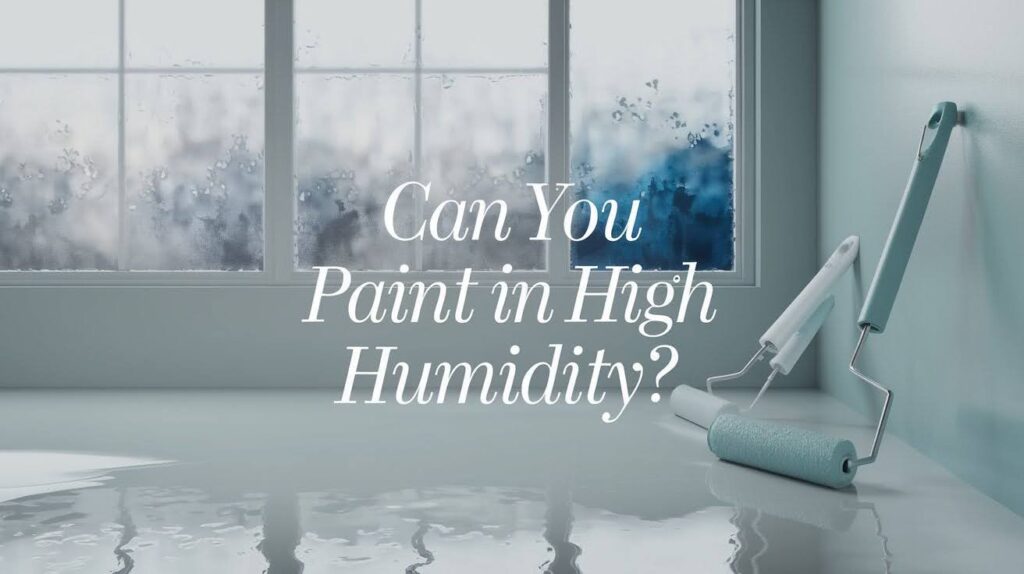I learned the hard way that moisture and paint create a frustrating combination when my first attempt at painting my kitchen turned into a sticky, streaky mess during a particularly humid summer week.
The paint refused to dry properly, leaving me with uneven coverage and wasted materials.
Many homeowners believe you simply can’t paint when humidity rises, but that’s not entirely accurate.
Others think any paint will work fine regardless of weather conditions – another costly mistake I’ve witnessed countless times.
The short answer is yes, you can paint in high humidity, but success depends on three critical factors: the specific humidity level you’re working with, the surface you’re painting, and the type of paint you choose for the job.
How Humidity Affects Painting Projects

High humidity disrupts paint drying and curing processes, causing streaks, blistering, and poor adhesion through altered evaporation rates.
What Is Humidity and Why Does It Matter?
Relative humidity (RH) measures the amount of moisture present in the air compared to the maximum amount it can hold at a given temperature.
This measurement directly impacts your painting success because humidity significantly slows down both the drying and curing processes that paint requires to form a proper finish.
When moisture levels rise, you’ll face frustrating surface issues, including streaks that won’t smooth out, blistering that creates an uneven texture, and poor adhesion that leads to peeling or flaking later.
These problems occur because excess moisture in the air prevents paint from setting properly on your prepared surfaces.
Humidity’s Effect on Paint Chemistry
Paint curing depends entirely on proper evaporation rates to create a durable, smooth finish. For optimal results, water components must evaporate faster than solvents, allowing the paint to form strong bonds with the surface underneath.
High relative humidity disrupts this delicate chemical balance by saturating the surrounding air with moisture. When evaporation slows dramatically, you end up with tacky or completely uncured finishes that remain soft and vulnerable to damage long after application.
What Humidity Levels Are Best for Painting?

Recommended Humidity Ranges
| Relative Humidity | Painting Advice |
| Below 40% | Not recommended – paint dries too fast |
| 40% to 50% | Ideal – best finish, proper curing |
| 50% to 70% | Acceptable – but drying time slows |
| 70% to 80% | Caution – apply in thin coats only |
| 80% to 85%+ | Avoid – paint won’t cure properly |
Interior vs. Exterior Painting
Interior painting projects face fewer humidity challenges due to controlled environments with air conditioning, heating, and dehumidifiers.
You can often modify indoor conditions to create acceptable painting weather regardless of outside conditions.
Exterior painting depends entirely on weather patterns, morning dew, and atmospheric humidity levels.
These uncontrolled factors make timing crucial – check weather forecasts and plan projects during stable, moderate humidity periods for best results.
Risks of Painting in High Humidity

High humidity causes immediate surface defects and long-term adhesion failures, leading to costly repairs and complete repainting.
Surface and Finish Issues
High humidity creates immediate problems that become visible during and shortly after paint application.
Uneven gloss and texture develop when moisture interferes with the paint’s ability to level properly across surfaces. Flashing occurs when paint sheen appears blotchy or inconsistent, creating an unprofessional appearance that’s difficult to correct.
Moist surfaces provide ideal conditions for mildew growth, which can begin developing beneath fresh paint within days of application.
The most frustrating immediate effect is paint that remains gummy or streaky long after it should have dried, leaving you with a finish that attracts dirt and shows every imperfection.
Long-Term Durability Problems
Poor adhesion represents the most serious consequence of painting in excessive humidity. When paint fails to bond properly with the surface, you’ll face peeling and bubbling months or years later, requiring extensive repairs that cost far more than waiting for better conditions.
In severe cases where paint completely fails to cure due to high moisture levels, you’ll need to strip all the failed coating and start over completely. This means losing both your time investment and material costs while dealing with the mess of paint removal.
How to Paint Successfully in Humid Conditions

Strategic timing, proper surface preparation, and modified application techniques enable successful painting projects even in challenging humid conditions.
Check and Control Humidity
Accurate measurement is essential for success, so invest in a hygrometer or sling psychrometer to get precise readings before starting any project.
Timing makes a significant difference – avoid early mornings when dew settles on surfaces and late afternoons when heat and humidity peak together.
Plan your painting sessions during late morning to early afternoon when conditions stabilize and offer the best balance of warmth and moderate moisture levels.
This timing allows surfaces to dry from morning dew while avoiding the intense heat that comes later in the day.
Surface Prep Tips
Patience pays off when dealing with moisture-affected materials. Allow wet wood or walls to dry completely for 1-2 days in sunny weather before attempting to paint.
Speed up indoor drying by running fans or dehumidifiers to create better air circulation and remove excess moisture from the environment.
Never skip the critical step of ensuring all surfaces are thoroughly dry before applying any coating. Even slightly damp surfaces will cause adhesion problems and finish defects that become apparent later.
Application Techniques
Apply thin, even coats rather than attempting to cover everything in one heavy application – this technique speeds drying and prevents moisture from getting trapped beneath thick paint layers.
Avoid painting in direct sunlight or on surfaces heated by the sun, as rapid moisture evaporation creates texture and adhesion issues.
Look for shaded areas that have been warmed by indirect sunlight for optimal painting conditions.
Skip dark paint colors on metal surfaces during hot, humid weather, as these combinations create the most challenging drying conditions.
When to Wait Instead of Paint
Red Flags That Say “Reschedule”
- Stop immediately if relative humidity exceeds 85% or any surfaces feel damp to the touch, as these conditions guarantee poor results.
- Check weather forecasts and postpone if rain or dew is expected within 24 hours of your planned painting session.
- Avoid indoor painting when there’s no ventilation or air movement to help moisture evaporate from fresh paint.
- Test uncoated wood by touch – if it feels cool, soft, or damp, the moisture content is too high for proper adhesion.
- Wait for clearer weather windows rather than rushing projects, as poor conditions lead to costly repairs later.
- Remember that patience saves both time and money by preventing adhesion failures and premature paint breakdown.
Conclusion
After countless painting projects in less-than-ideal conditions, I can confidently say yes, you can paint in high humidity – but success requires proper planning and technique.
I’ve learned that sticking to the 40-70% relative humidity range saves you from headaches and expensive mistakes.
The key lessons I’ve gathered over the years boil down to three essentials: prep your surfaces thoroughly, adjust your timing based on weather patterns, and invest in the right products designed for challenging conditions.
These steps prevent costly do-overs that eat into both your budget and patience.
When doubt creeps in about conditions, trust your instincts and wait for drier weather. Your future self will appreciate the professional results, and your walls will reward you with lasting beauty.
Frequently Asked Questions
What humidity level is too high for painting?
Avoid painting when relative humidity exceeds 80-85%, as paint won’t cure properly and will remain tacky. The ideal range is 40-70% humidity for best results and proper drying.
How long should I wait after rain to start painting?
Wait at least 24-48 hours after rain, depending on surface material and weather conditions. Test surfaces by touch – they should feel completely dry and warm before applying paint.
Can I use a dehumidifier to improve painting conditions indoors?
Yes, running a dehumidifier indoors can lower humidity levels and create better painting conditions. Combine with fans for air circulation to speed up the drying process significantly.
Why does my paint look streaky when the humidity is high?
High humidity slows paint drying, preventing proper flow and leveling across the surface. This causes brush marks and roller texture to remain visible instead of smoothing out naturally.
Should I use different paint types in humid weather?
Choose paints specifically formulated for humid conditions, such as those with mildew-resistant additives. Oil-based paints generally handle humidity better than standard latex paints in challenging conditions.

